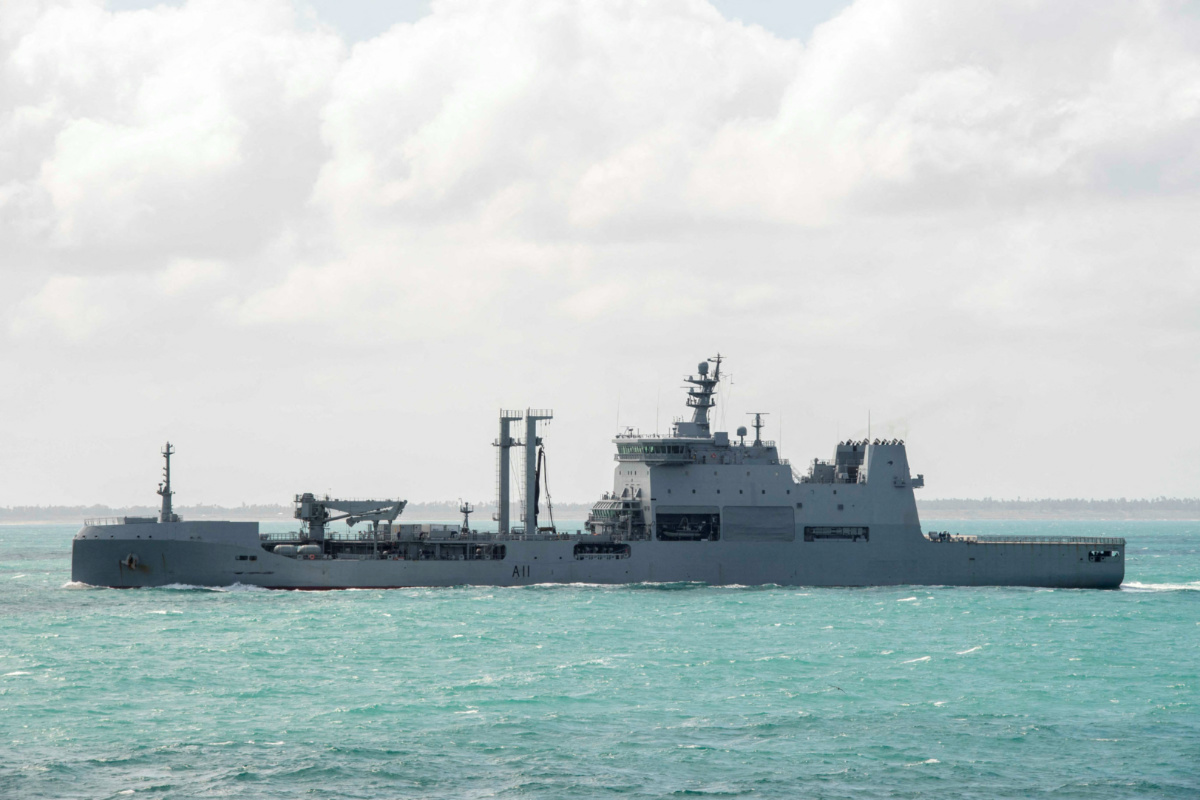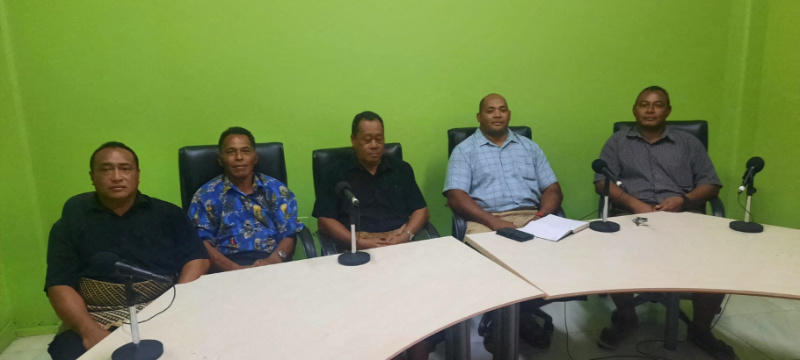Wellington, New Zealand/Sydney, Australia
Reuters
Life-saving water supplies from a New Zealand navy ship were distributed across Tonga’s main island on Friday, as other countries battled the logistics of delivering aid to one of the world’s remotest communities.

Royal New Zealand Navy’s HMNZS Aotearoa sails in the sea off the coast of Tonga, on 21st January. PICTURE: New Zealand Defence Force/Handout via Reuters.
Six days after the South Pacific archipelago was devastated by a volcanic eruption and tsunami that deposited a blanket of ash and polluted its water sources, the HMNZS Aotearoa docked in the capital, Nuku’alofa.
The ship carried 250,000 litres of water and desalination equipment able to produce 70,000 litres more per day, New Zealand’s High Commission said.
“Trucks…have begun collecting and delivering water supplies from Aotearoa,” the Commission said on its Facebook page.
The first flights from Australia and New Zealand landed on Thursday with some water as well as shelter, communication equipment and generators.
On Thursday, an Australian flight was forced to return to base because of a positive COVID-19 case onboard, while on Friday technical problems delayed one of two Japanese C-130 transporters carrying 5,000 litres of drinking water, Japan’s Self-Defence Forces said.
Underlining the complexity of mounting a contactless international aid operation to one of the few countries free of COVID-19, the Australian plane was turned around mid-flight after PCR tests showed a positive result, an Australian defence spokeswoman told Reuters.
All crew had earlier returned negative rapid antigen tests, she said. The supplies were moved to another flight that took off on Friday.
The Hunga Tonga-Hunga Ha’apai volcano eruption last Saturday triggered a tsunami that destroyed villages and resorts and knocked out communications for the nation of about 105,000 people. Three people have been reported killed, authorities said.
‘LIFE AND DEATH’ AT SEA: LOG KEEPS TONGA’S ‘AQUAMAN’ FROM GOING UNDER

Lisala Folau (wearing blue printed shirt), a Tongan man who says he swam for around 27 hours after getting swept to sea by Saturday’s tsunami, sits with other people of Atata island in Nuku’alofa, Tonga, on 19th January in this picture obtained from social media. PICTURE: Marian Kupu/Broadcom Broadcasting FM87.5/via Reuters.
A 57-year-old Tongan man being hailed a real-life Aquaman for surviving 27 hours at sea after Saturday’s devastating tsunami struck his island said he went under nine times before latching onto a log and making it to safety.
“On the eighth time I thought, the next time I go underwater that’s it, because my arms were the only things that were keeping me above water,” said Lisala Folau, who is disabled and cannot walk properly, speaking to Reuters from Tonga’s capital, Nuku’alofa.
“So the ninth time I went under and came up and grabbed a log. And that’s what kept me going.”
Folau, who lived on the isolated island of Atata, with a population of about 60 people, was swept out to sea at around 7pm last Saturday.
He had climbed a tree to escape a first wave but when he got down, another big wave swept him out.
“I could hear my son calling from land but I didn’t want to answer my son because I didn’t want him to swim out to find me,” said Folau.
“The waves kept twirling around here and there…what came to mind is, at sea there is life and death. Until you reach the shore, then you know if you are alive or dead.”
Folau said he slowly managed to swim 7.5 kilometres to the main island of Tongatapu, reaching the shore 27 hours later at about 10pm on Sunday.
His heroics have gone viral on social media, with one Facebook post calling him a “real life Aquaman”, referring to the comic book and film character.
When asked if he knew who Aquaman was, Flolau said he didn’t yet.
Reuters was unable to independently verify the events.
Atata, about eight kilometres north-west of Nuku’alofa, or a 30-minute boat ride, has been almost entirely destroyed in the tsunami that hit the islands.
– JILL GRALOW, Sydney Australia/Reuters
The salt water from the tsunami spoiled most sources of water and Tongans have been struggling to find clean water as they clear away the ash.
“We are cleaning the ash and have been since Monday,” said Branko Sugar, 61, who runs a bottle shop and fishing charter business from Nuku’alofa.
“Everything is so dusty, and we are running out of water,” he said over a patchy telephone line. “We only have the tap water, and it’s been contaminated. We… can hardly breathe for all the dust.”
Urgent assistance needed
NASA’s Goddard Space Flight Center has said the force of the eruption was estimated to be equivalent to 5 to 10 megatons of TNT, or more than 500 times that of the nuclear bomb the United States dropped on the Japanese city of Hiroshima at the end of World War II.
Astronaut Kayla Barron said she could see the volcanic ash in the atmosphere from the International Space Station.
“I opened the window shutter to see if we could see any effects of the eruption, and saw this dramatic, high-altitude plume blocking out the sun,” Barron said on Facebook.
NASA released photographs showing a huge grey smudge over the blue Pacific.
United Nations spokesperson Stéphane Dujarric told a briefing Tonga had asked for urgent assistance.
“We remain seriously concerned about access to safe water for 50,000 people…Water quality testing continues, and most people are relying on bottled water,” he said, speaking before the Aotearoa arrived.
Dujarric said there were reports of fuel shortages, while some 60,000 Tongans have been affected by damage to crops, livestock and fisheries due to ashfall, saltwater intrusion and the potential for acid rain.
Many have turned to social media to post images of the destruction by the tsunami and give accounts of their shock after the massive explosion, while tales of incredible escapes from the disaster have also emerged.
Sea-borne assistance was also en route for the archipelago.
Australia’s HMAS Adelaide was due in Tonga next week after leaving Brisbane.
Reliance, a repair ship due to reconnect the undersea cable that links Tonga to international telecoms networks, left its Port Moresby mooring and was expected in Tonga on 30th January, according to Refinitiv data on shipping movements.
The Reliance‘s operator, SubCom, did not immediately reply to a Reuters request for confirmation.
Telephone links between Tonga and the outside world were reconnected late on Wednesday, although restoring full internet services is expected to take a month or more.
Tesla Chief Executive Officer Elon Musk asked in a post on Twitter if Tongans would like help from his Starlink project, which provides internet connection through satellites.





